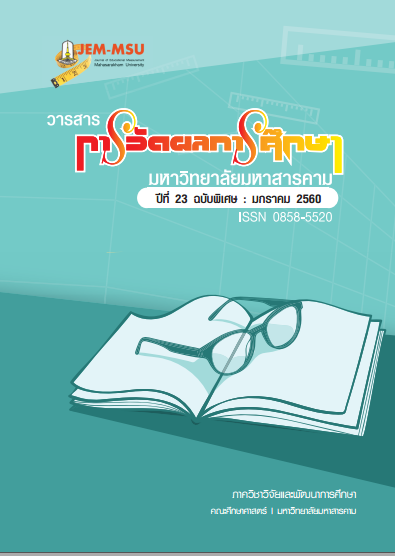Comparisons of Learning Achievement and Computer Subject Attitude Learning of Career and Technology Entitled Data Communication and Computer Network Students Matayomsueksa 2 Between Learning by Using Cooperative Learning : the Jigsaw 2 Technique and Group Investigation Technique
Main Article Content
Abstract
The Career and Technology studies learning and instruction were not successful
because of learning activities lacked the variety and interesting approaches, and also were
not suitable with the students’ individual differences. The teaching approaches those were
appropriate and can support to the students learning successful, consisted of using Jigsaw 2
approach and Group Investigation Technique. The purposes of this research were : (1) to
develop the lesson plans using the jigsaw 2 learning approach and group investigation
technique with a required efficiency of 80/80, (2) to find out effectiveness indices of those
two types of learning activities, (3) to compare learning achievement, before and after
learned by using the two different approaches, (4) to compare learning achievement,
toward computer subject learning of the students who learned by using the two different
approaches. (5) to compare learning attitude, toward computer subject learning of the
students who learned by using the two different approaches. The sample used in this study
consisted of 60 Mathayomsuksa 2 students attending Bantakon School, Muangchan District,
Sisaket Province in the first semester of the academic year 2012, who were selected by the
cluster random sampling technique. They were assigned to one experimental group with 30
students learned using the jigsaw 2 learning approach and the another experimental group
with 30 students learned using group Investigation learning approach. The instruments used
in the study were : plans for organization of learning activities using the jigsaw 2 learning
approach and group Investigation learning approach, 2 hours per week in each plan, for a
total of 16 hours of teaching. achievement test on 30 items 4 alternative with discriminating
power ranging .38 – .78 and reliability of 0.94, and scientific attitude test on 21 items 5 likert
scales with discriminating power ranging (t-test) 3.84 – 0.77 and reliability of 0.95. The
statistics used for analyzing data were percentile mean and standard deviation ; and t-test
(Independent samples) was employed for testing hypotheses
The results of the study were as follows:
1. The plans for organization of learning activities using the jigsaw 2 learning
approach and group Investigation approach, entitled Data Communication and Computer
Network of 82.81/83.89 and 82.86/83.44 respectively.
2. The effectiveness indices of plans for organization of learning activities using
the jigsaw 2 learning approach and group Investigation learning approach, entitled The Data
Communication and Computer Network Truths were 0.7509 and 0.7525 respectively.
3. The students learning achievement were different before studying by using
the jigsaw 2 learning approach and those learned using group Investigation activity, and The
students learning achievement were not different after studying by using the jigsaw 2
learning approach and those learned using group Investigation activity
4. The students who learned by using the jigsaw 2 learning approach and those
learned using Group Investigation learning approach did not show different learning
achievement, toward computer subject learning.
5. The students who learned by using the jigsaw 2 learning approach and Those
learned using group Investigation learning approach did not show different learning attitude,
toward computer subject learning.
Article Details
The content and information contained in the published article in the Journal of Educational Measurement Mahasarakham University represent the opinions and responsibilities of the authors directly. The editorial board of the journal is not necessarily in agreement with or responsible for any of the content.
The articles, data, content, images, etc. that have been published in the Journal of Educational Measurement Mahasarakham University are copyrighted by the journal. If any individual or organization wishes to reproduce or perform any actions involving the entirety or any part of the content, they must obtain written permission from the Journal of Educational Measurement Mahasarakham University.


